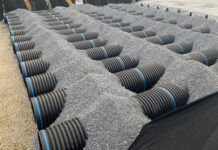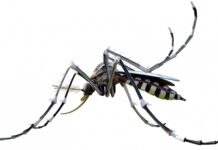From Biological Products Industry Alliance (BPIA)
From the Spring 2019 Issue
There is nothing more fun than waking up early on a Saturday morning and meeting some good friends to play a round of golf on a meticulously maintained course. It doesn’t matter whether it is your private country club or your local public course. Everyone enjoys playing on a good looking and pest-free course. Conversely, nothing is more miserable than trying to golf on a course that is in poor condition from turf disease or being overrun by a variety of buzzing and stinging insects.

Two decades ago, most players wouldn’t have given a second thought as to what goes into maintaining their favorite place to play golf. They just wanted it to look scenic and be pest free. But times have definitely changed. Many people including golfers and golf course superintendents are trying to be ecologically responsible and live lifestyles which help sustain our natural resources and protect all aspects of our outdoor environment including on golf courses.
For many years, golf course superintendents and their staff used a diverse assortment of very effective synthetic chemicals to eliminate unwanted pests and help improve the appearance of greens. The reality is that little consideration was given to the environmental consequences, and also there were very few efficacious alternatives available.
“The market is definitely shifting since there are now many cost-effective biological products available for use on turf,” says Eric Smith, East Coast sales manager for BioSafe Systems.
“These biopesticide products include a wide variety of natural pest control options such as bacteria and fungi that can be just as effective as man-made chemistry but have little or no effect on human health or the environment,” Smith continues.
[two_third]There are now commercially available biopesticides that control hundreds of insect species commonly found on the tees, fairways, and greens of golf course sites, including the following: Nematodes; Chinch Bugs; Grubs; Sod Worms; Billbugs; Cut Worm; Armyworm; Weevils; Mole; Crickets; and Mites.
Many of these products meet all the requirements of the USDA National Organic Program and now play a critical role in Integrated Pest Management, or IPM, plans for pest and disease control on courses. (More information about the USDA National Organic Program can be found online.)
Biological products are reduced-risk products based on biological or naturally derived chemistry. The Biological Products Industry Alliance (BPIA) defines biopesticides as reduced risk pesticides that are naturally derived or synthetic equivalents of natural materials such as animals, plants, bacteria, fungi, and certain minerals, generally posing little risk to humans or the environment. A biostimulant is defined as a substance or micro-organism whose function when applied to seeds, plants, or the rhizosphere is to stimulate natural processes to enhance or benefit nutrient uptake, nutrient efficiency, tolerance to abiotic stress, and crop quality or yield.
New Age In Pest Control And Turf Growth
The willingness to try these innovative but natural products can sometimes be generational.
“The job of golf course superintendent can be stressful with a great deal of pressure to maintain the appearance of the course, so a veteran superintendent might tend to rely on conventional chemistry and daily spraying,” says Smith. “But a new superintendent looking to make their mark might say, ‘I’m going to do things in a different way, which now includes some courses that have gone completely biological with their programs.’”

A common misconception about biological products is that they will be difficult to use because they often include application of a living organisms to the turf. In recent years, a great deal of work has gone into simplifying the application process for biological products. Typical directions are to simply mow the greens and run irrigation prior to application to help with saturation then apply a wettable powder formulation that can easily be sprayed on turf grass. Once a kill is achieved rake to remove the unwanted organisms such as moss and reapply as necessary, thoroughly irrigate, and within 24 to 48 hours re-seed.
“There are many reasons golf and turf markets have begun to incorporate biological products into their programs,” says Darrell Thorpe, regional sales manager for Agrinos. “For one, biostimulants can provide improved soil and plant heath, which directly results in greener, more attractive golf courses. They also increase turf tolerance to environmental stressors like heat, drought, or excessive rain. Finally, there are important environmental benefits associated with using microbials and other biostimulants, such as increased fertilizer efficiency, reduced runoff, reduced CO2 emissions, better water utilization, and reduced water usage.”
Biologicals are an investment in healthier soils, and healthier soils mean healthier grass. Some biological products, for example, can increase root biomass—and since superintendents trim the growing point off the grass every few days, using biologicals will help their fairways stay greener, resulting in a more attractive golf course for players and the community.
“Biostimulant products provide benefits by strengthening the soil microbiome and delivering critical, highly bioavailable nutrients to help plants prosper,” says Thorpe. “Once integrated into the golf course superintendent’s practices, biological products have been proven to perform consistently across a broad range of plants, soils, and environments.”
Greens May Get Greener
While Saturday morning golfers still want to play on nice looking courses without being subjected to bothersome insects or other annoying pests, increasingly they now also care about how that course is being kept in such an enjoyable and pleasant condition and whether there are any harmful environmental consequences of that maintenance. As a result, the use of biological products such as biopesticides and biostimulants on golf courses is sure to continue to grow and help make the fairway greens a lot greener in more ways than one.
The Biological Products Industry Alliance (BPIA) is the premier organization dedicated to fostering the use of biological technology including biopesticides and biostimulants. BPIA is a rapidly growing association with now over 130 member companies ranging from small, innovative sole proprietors to large, international companies. Member companies have developed dependable, pioneering products for commercial agriculture, forestry, home gardens, horticulture, ornamentals, public health, and turf.
Do you have a comment? Share your thoughts in the Comments section below or send an e-mail to the Editor at acosgrove.turf@groupc.com.
[/two_third]
[one_third_last]
Golf Courses: Healthy Land Stewardship
Compiled by Turf Staff
The Golf Course Superintendents Association of America has recognized 12 winners for its 2018 Environmental Leaders in Golf Awards (ELGA). Given since 1993, the awards were updated to recognize superintendents in focused areas of environmental sustainability. Instead of offering national awards based on facility type, the new version of the ELGAs is based on the environmental best management practices and honor specific areas of focus: Natural Resource Conservation; Healthy Land Stewardship; Communications and Outreach; and Innovative Conservation.
The 2018 Healthy Land Stewardship Award was given to Shannon Easter, golf course maintenance director of Broken Sound Club in Boca Raton, FL.
The 21-year GCSAA member’s soil program incorporates organic, biological, and carbon-based products to improve soil health while repurposing the courses’s organic waste material into reusable compost that is spread on the course. The integrated pest management (IPM) plan at Broken Sound employs proper cultural practices, mechanical controls or biological controls first, with chemicals only used as a last resort. The property features many lakes, providing potential habitat for wading birds. By adding more than 20,000 plants along the lake beds in the past five years, the course’s population of wading birds has increased by 75%. The property also includes 30 snags to attract large birds of prey, 30 birdhouses, seven butterfly gardens and 22 beehives that have produced 1,500 gallons of honey.
First runner-up in the Healthy Land Stewardship category is Jeff Reich, superintendent at TPC River Highlands in Cromwell, CT. Second runner-up is Wayne Mills, superintendent at La Cumbre Country Club in Santa Barbara, CA.

[/one_third_last]











![[VIDEO] Dickies®: Discover Workwear That’s Anything But Uniform](https://turfmagazine.com/wp-content/uploads/2023/06/1647663814-4b1a2a7742790a9b1e97a3b963477850192e1d6a9dfba9b07214a77bae25d6e3-d-218x150.jpg)




























![[VIDEO] Dickies®: Discover Workwear That’s Anything But Uniform](https://turfmagazine.com/wp-content/uploads/2023/06/1647663814-4b1a2a7742790a9b1e97a3b963477850192e1d6a9dfba9b07214a77bae25d6e3-d-324x160.jpg)